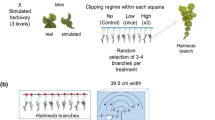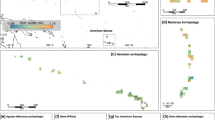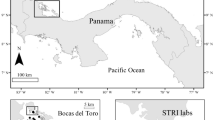Abstract
Seasonal variation in coral reef macroalgal size and condition is well documented, yet seasonal variability of herbivory on macroalgae by coral reef fishes is unknown. Herbivore feeding intensity was quantified monthly on an inner-shelf reef on the Great Barrier Reef, using Sargassum bioassays. Removal rates of transplants displayed high levels of variation with significantly higher rates of removal during the summer months. Differences in Sargassum plant size and condition suggest that the variability in herbivore feeding intensity is attributed primarily to the variation in the condition of the macroalgae, especially epiphyte loads. The dramatic changes in macroalgal removal reveal a considerable decrease in herbivore activity in the winter. This highlights the clear distinction between ‘summer’ and ‘winter’ months in terms of reef processes, emphasizing the high seasonal variation in macroalgal removal rates at different time of the year.






Similar content being viewed by others
References
Arenas F, Fernandez C (2000) Size structure and dynamics in a population of Sargassum muticum (Phaephyceae). J Phycol 36:1012–1020. doi:10.1111/j.1529-8817.2000.99235.x
Ateweberhan M, Bruggemann JH, Breeman AM (2005) Seasonal dynamics of Sargassum ilicifolium (Phaeophyta) on a shallow reef flat in the southern Red Sea (Eritrea). Mar Ecol Prog Ser 292:159–171. doi:10.3354/meps292159
Ateweberhan M, Bruggemann JH, Breeman AM (2006) Effects of extreme seasonality on community structure and functional group dynamics of coral reef algae in the southern Red Sea (Eritrea). Coral Reefs 25:391–406. doi:10.1007/s00338-006-0109-6
Ateweberhan M, Bruggemann JH, Breeman AM (2008) Seasonal module dynamics in Sargassum subrepandum (Fucales, Phaeophyta). J Phycol 44:269–283. doi:10.1111/j.1529-8817.2008.00463.x
Bellwood DR (1995) Direct estimate of bioerosion by two parrotfish species, Chlorurus gibbus and C. sordidus, on the Great Barrier Reef, Australia. Mar Biol 121:419–429. doi:10.1007/BF00349451
Bellwood DR, Choat JH (1990) A functional analysis of grazing in parrotfishes (family Scaridae): the ecological implications. Environ Biol Fish 28:189–214. doi:10.1007/BF00751035
Bellwood DR, Hughes TP, Folke C, Nyström M (2004) Confronting the coral reef crisis. Nature 429:827–833. doi:10.1038/nature02691
Bellwood DR, Hughes TP, Hoey AS (2006) Sleeping functional group drives coral reef recovery. Curr Biol 16:2434–2439. doi:10.1016/j.cub.2006.10.030
Clements KD, Choat JH (1997) Comparison of herbivory in the closely-related marine fish genera Girella and Kyphosus. Mar Biol 127:579–586. doi:10.1007/s002270050048
Clements KD, Raubenheimer D, Choat JH (2009) Nutritional ecology of marine herbivorous fishes: ten years on. Funct Ecol 23:79–92. doi:10.1111/j.1365-2435.2008.01524.x
Creed JC, Kain JM, Norton TA (1998) An experimental evaluation of density and plant size in two large brown seaweeds. J Phycol 34:39–52
Cronin G, Hay ME (1996) Susceptibility to herbivores depends on recent history of both the plant and animal. Ecology 77:1531–1543
Cruz-Rivera E, Hay ME (2000) Can quantity replace quality? Food choice compensatory feeding, and fitness of marine mesograzers. Ecology 81:201–219
Cvitanovic C, Bellwood DR (2009) Local variation in herbivore feeding activity on an inshore reef of the Great Barrier Reef. Coral Reefs 28:127–133. doi:10.1007/s00338-008-0433-0
Diaz-Pulido G, McCook LJ (2005) Effects of nutrient enhancement of the fecundity of a coral reef macroalga. J Exp Mar Biol Ecol 317:13–24. doi:10.1016/j.jembe.2004.11.013
Diaz-Pulido G, McCook LJ, Larkum AWD, Lotze HK, Raven JA, Schaffelke B, Smith JE, Steneck RS (2007) Vulnerability of macroalgae of the Great Barrier Reef to climate change. In: Johnson JE, Marshall PA (eds) Climate change and the Great Barrier Reef: a vulnerability assessment. Great Barrier Reef Marine Park Authority and Australian Greenhouse Office, Australia, pp 153–192
Duffy JE, Hay ME (1990) Seaweed adaptations to herbivory: chemical, structural, and morphological defences are often adjusted to spatial or temporal patterns of attack. Bioscience 40:368–375
Ferreira CEL, Peret AC, Coutinho R (1998) Seasonal grazing rates and food processing by tropical herbivorous fishes. J Fish Biol 53:222–235. doi:10.1111/j.1095-8649.1998.tb01029.x
Fox RJ, Bellwood DR (2007) Quantifying herbivory across a coral reef depth gradient. Mar Ecol Prog Ser 339:49–59. doi:10.3354/meps339049
Fox RJ, Bellwood DR (2008) Remote video bioassays reveal the potential feeding impact of the rabbitfish Siganus canaliculatus (f: Siganidae) on an inner-shelf reef of the Great Barrier Reef. Coral Reefs 27:605–615. doi:10.1007/s00338-008-0359-6
Fris MB, Horn MH (1993) Effects of diets of different protein content on food consumption, gut retention, protein conversion, and growth of Cebidichthys violaceus (Girard), an herbivorous fish of temperate zone marine waters. J Exp Mar Biol Ecol 166:185–202. doi:10.1016/0022-0981(93)90218-D
Glenn EP, Smith CM, Doty MS (1990) Influence of antecedent water temperatures on standing crop of a Sargassum spp. dominated reef flat in Hawaii. Mar Biol 105:323–328. doi:10.1007/BF01344302
Goecker ME, Heck KL Jr, Valentine JF (2005) Effects of nitrogen concentrations in turtlegrass Thalassia testudinum on consumption by the bucktooth parrotfish Sparisoma radians. Mar Ecol Prog Ser 286:239–248. doi:10.3354/meps286239
Graham NAJ, Wilson SK, Jennings S, Polunin NVC, Bijoux JP, Robinson J (2006) Dynamic fragility of oceanic coral reef ecosystems. Proc Natl Acad Sci USA 103:8425–8429. doi:10.1073/pnas.0600693103
Hatcher BG (1981) The interaction between grazing organisms and the epilithic algal community of a coral reef a quantitative assessment. Proc 4th Int Coral Reef Symp, Manila 2:515–524
Hoey AS, Bellwood DR (2008) Cross-shelf variation in the role of parrotfishes on the Great Barrier Reef. Coral Reefs 27:37–47. doi:10.1007/s00338-007-0287-x
Hoey AS, Bellwood DR (2009) Limited functional redundancy in a high diversity system: single species dominates key ecological processes on coral reefs. Ecosystems 12:1316–1328. doi:10.1007/s10021-009-9291-z
Hughes TP, Szmant AM, Steneck RS, Carpenter R, Miller S (1999) Algal blooms on coral reefs: what are the causes? Limnol Oceanogr 44:1583–1586
Hughes TP, Baird AH, Bellwood DR, Card M, Connolly SR, Folke CS, Grosberg R, Hoegh-Guldberg O, Jackson JBC, Kleypas J, Lough JM, Marshall P, Nyström M, Palumbi SR, Pandolfi JM, Rosen B, Roughgarden J (2003) Climate change, human impacts, and the resilience of coral reefs. Science 301:929–933. doi:10.1126/science.1085046
Hughes TP, Rodrigues MJ, Bellwood DR, Ceccarelli D, Hoegh-Guldberg O, McCook LJ, Moltschaniwskyj N, Pratchett MS, Steneck RS, Willis B (2007) Phase shifts, herbivory, and the resilience of coral reefs to climate change. Curr Biol 17:360–365. doi:10.1016/j.cub.2006.12.049
Hurtado AQ, Ragaza AR (1999) Sargassum studies in Currimao, Ilocos Norte, northern Philippines. I. Seasonal variations in the biomass of Sargassum carpophyllum J Agardh, Sargassum ilicifolium (Turner) C Agardh and Sargassum siliquosum J Agardh (Phaeophyta, Sargassaceae). Bot Mar 42:321–325
Kendrick GA, Walker DI (1994) Role of recruitment in structuring beds of Sargassum spp. (Phaeophyta) at Rottnest Island, Western Australia. J Phycol 30:200–208
Kilar JA, Hanisak MD (1988) Seasonal patterns of morphological variability in Sargassum polyceratium (Phaeophyta). J Phycol 24:467–473
Kilar JA, Hanisak MD, Yoshida T (1992) On the expression of phenotypic variability: why is Sargassum so taxonomically difficult? In: Abbott IA (ed) Taxonomy of economic seaweeds with reference to some Pacific and Western Atlantic Species 3. California Sea Grant College, University of California, California, pp 95–117
Kirsch KD, Valentine JF, Heck KL (2002) Parrotfish grazing on turltegrass (Thalassia testudinum): evidence for the importance of seagrass consumption in food web dynamics of the Florida Keys National Marine Sanctuary. Mar Ecol Prog Ser 227:71–85. doi:10.3354/meps227071
Lazo ML, Chapman ARO (1998) Components of crowding in a modular seaweed: sorting through the contradictions. Mar Ecol Prog Ser 174:257–267. doi:10.3354/meps174257
Mantyka CS, Bellwood DR (2007) Macroalgal grazing selectivity among herbivorous coral reef fishes. Mar Ecol Prog Ser 352:177–185. doi:10.3354/meps07055
Martin-Smith KM (1992) Seasonal variation in tropical benthic Sargassum and associated motile epifauna. Proc 7th Int Coral Reef Symp, Guam 2:881–886
McCook LJ (1996) Effects of herbivores and water quality on Sargassum distribution on the Central Great Barrier Reef: cross-shelf transplants. Mar Ecol Prog Ser 139:179–192. doi:10.3354/meps139179
McCook LJ (1997) Effects of herbivory on zonation of Sargassum spp. within fringing reefs of the central Great Barrier Reef. Mar Biol 129:713–722. doi:10.1007/s002270050214
McCourt RM (1984) Seasonal patterns of abundance, distributions, and phenology in relation to growth strategies of three Sargassum species. J Exp Mar Biol Ecol 74:141–156. doi:10.1016/0022-0981(84)90082-0
Mumby PJ, Dahlgren CP, Harborne AR, Kappel CV, Micheli F, Brumbaugh DR, Holmes KE, Mendes JM, Broad K, Sanchirico JN, Buch K, Box S, Stoffle RW, Gill AB (2006) Fishing, trophic cascades, and the process of grazing on coral reefs. Science 311:98–101. doi:10.1126/science.1121129
Nizamuddin M (1970) Phytogeography of the Fucales and their seasonal growth. Bot Mar 13:131–139
Paddack MJ, Cowen RK, Sponaugle S (2006) Grazing pressure of herbivorous coral reef fishes on low coral-cover reefs. Coral Reefs 25:461–472. doi:10.1007/s00338-006-0112-y
Pandolfi JM, Bradbury RH, Sala E, Hughes TP, Bjorndal KA, Cooke RG, McArdle D, McClenachan L, Newman MJH, Paredes G, Warner RR, Jackson JBC (2003) Global trajectories of the long-term decline of coral reef ecosystems. Science 301:955–958. doi:10.1126/science.1085706
Polunin NVC, Klumpp DW (1992) Algal food supply and grazer demand in a very productive coral-reef zone. J Exp Mar Biol Ecol 164:1–15. doi:10.1016/0022-0981(92)90132-T
Price IR (1989) Seaweed phenology in a tropical Australian locality (Townsville, North Queensland). Bot Mar 32:399–406
Price PW, Bouton CE, Gross P, McPheron MA, Thompson JN, Weiss AE (1980) Interactions among three trophic levels: influence of plants on interactions between insect herbivores and natural enemies. Ann Rev Ecol Syst 11:41–65
Reinthal PN, Macintyre IG (1994) Spatial and temporal variations in grazing pressure by herbivorous fishes: tobacco Reef, Belize. Atoll Res Bull 425:1–11
Rivera M, Scrosati R (2006) Population dynamics of Sargassum lapazeanum (Fucales, Phaeophyta) from the Gulf of California, Mexico. Phycologia 45:178–189. doi:10.2216/05-47.1
Schaffelke B, Klumpp DW (1997) Biomass and productivity of tropical macroalgae on three nearshore fringing reefs in the central Great Barrier Reef, Australia. Bot Mar 40:373–383
Smith TB (2008) Temperature effects on herbivory for an Indo-Pacific parrotfish in Panama: implications for coral-algal competition. Coral Reefs 27:397–405. doi:10.1007/s00338-007-0343-6
Smith JE, Smith CM, Hunter CL (2001) An experimental analysis of the effects of herbivory and nutrient enrichment on benthic community dynamics on a Hawaiian reef. Coral Reefs 19:32–342. doi:10.1007/5003380000124
Snedecor GW, Cochran WG (1980) Statistical methods. Iowa State University Press, Iowa
Steinberg PD (1992) Geographical variation in the interaction between marine herbivores and brown algal secondary metabolites. In: Paul VJ (ed) Ecological roles of marine natural products. Comstock Publishing Associates, Ithaca, pp 51–92
Targett TE, Targett NM (1990) Energetics of food selection by the herbivorous parrotfish Sparisoma radians: roles of assimilation efficiency, gut evacuation rate, and algal secondary metabolites. Mar Ecol Prog Ser 66:13–21
Valentine J, Duffy J (2006) The central role of grazing in seagrasses ecosystems. In: Larkum A, Orth R, Duarte C (eds) Seagrasses: biology, ecology and conservation. Springer, New York, pp 463–501. doi:10.1007/1-4020-2983-d7_20
Valentine JF, Heck KL (2001) The role of leaf nitrogen content in determining turtlegrass (Thalassia testudinum) grazing by a generalized herbivore in the northeastern Gulf of Mexico. J Exp Mar Biol Ecol 258:65–86. doi:10.1016/S0022-0981(00)00342-7
Vroom PS, Page KN, Peyton KA, Kukea-Shultz JK (2005) Spatial heterogeneity of benthic community assemblages with an emphasis on reef algae at French Frigate Shoals, Northwestern Hawaiian Islands. Coral Reefs 24:574–581. doi:10.1007/s00338-005-0028-y
Vuki VC, Price IR (1994) Seasonal changes in the Sargassum populations on a fringing coral-reef, Magnetic Island, Great Barrier Reef region, Australia. Aquat Bot 48:153–166. doi:10.1016/0304-3770(94)90082-5
Wilkinson C (ed) (2002) Status of coral reefs of the world. Australian Institute of Marine Science, Townsville
Wilson SK, Bellwood DR, Choat JH, Furnas MJ (2003) Detritus in the epilithic algal matrix and its use by coral reef fishes. Oceanogr Mar Biol Annu Rev 41:279–309
Wismer S, Hoey AS, Bellwood DR (2009) Cross-shelf benthic community structure on the Great Barrier Reef: relationships between macroalgal cover and herbivore biomass. Mar Ecol Prog Ser 376:45–54. doi:10.3354/meps07790
Acknowledgments
We thank the staff of Orpheus Island Research Station for field support; S. Bennett, R. Bonaldo, L. Dickens, R. Fox, A. González-Cabello, A. Hoey and S. Wismer for field assistance; A. Beresford, C. Goatley, A. González-Cabello, A. Hoey, M. Pratchett, R. Rowe, G. Russ, J. Tanner, S. Wismer and anonymous reviewers for helpful discussions or comments on earlier drafts of the manuscript and the Research School of Biological Sciences, Australian National University for C:N analyses. This work was supported by the Australian Research Council (D.R.B). These experiments comply with current Australian legislation.
Author information
Authors and Affiliations
Corresponding author
Additional information
Communicated by D. Goulet.
Electronic supplementary material
Below is the link to the electronic supplementary material.
Rights and permissions
About this article
Cite this article
Lefèvre, C.D., Bellwood, D.R. Seasonality and dynamics in coral reef macroalgae: variation in condition and susceptibility to herbivory. Mar Biol 157, 955–965 (2010). https://doi.org/10.1007/s00227-009-1376-x
Received:
Accepted:
Published:
Issue Date:
DOI: https://doi.org/10.1007/s00227-009-1376-x




